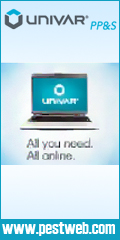
| December 2011 | Past Issues | Printer-Friendly | Advertise | Affiliates Search | Find a Pest Control Operator | PCOC.org |
|
EVP NOTES
The time between Thanksgiving and Christmas, I find, is usually a time to reflect upon the things I have to be thankful for. I find that Christmas has become far too commercialized for me. In fact, we should probably separate the religious from the secular holiday. Thanksgiving, on the other hand, is my favorite holiday: growing up in England, we did not have a Thanksgiving holiday. My first recollections of one are attending a party in London, put on by a bunch of Americans, when I was studying as a Barrister. Then, it was a succession of wild celebrations in New York in the next two years...and that was more than 40 years ago! Seriously, the reason why Thanksgiving is so enjoyable for me is that there is not commercial angle attached to it...that comes the day after! So, instead of focusing on the commercialism of the shopping frenzy during the days between Thanksgiving and Christmas, I prefer to keep in mind the things I can be thankful for. Therefore, in the spirit of this Season, I thought I would list, in no particular order, some items that I offer for us all to keep at the back of our minds during this time of year. Our families, business colleagues, friends and neighbors. I've found that within our PCOC family all of these categories may include the same people! The country in which we live. Sometimes, we take our freedoms for granted—at least we wear them lightly. We live in the greatest country in the world. We are able enjoy the freedom to speak, conduct business, travel and live, to name but a few that come to mind immediately. The state in which we live–California–is blessed with more things than a fantastic climate, don't you think? Even though we complain all the time about our overreaching state government, compare this to other places in the world where you wouldn't want to live because of dictatorship or oppressive regimes. And finally: our industry and our trade associations: PCOC and our national organization, NPMA. The pest control industry is one of the backbones of our state economy and fulfills an essential service for all Californians. I believe also that our industry is so fortunate to have such strong trade associations working to protect the industry. When you look at other states and look at how we deploy our resources, you should be proud of your trade association. ...just some of the things to be thankful for. IN MEMORIAM Marie Evans, PCOC Past President 2005-2006, Northstar Exterminators Chuck Homer, PCOC Honorary Member, Homer Pest Control LEGISLATIVE UPDATE
UPCOMING EVENTS
2011
December 15
Africanized Honeybee Certification Class
Embassy Suites Hotel Temecula, CA 2012 January 10
January 11 March 23-24
Board of Directors Meeting Seascape Beach Resort Aptos, CA April 24-25 Leg Day 2012
Hyatt Regency Sacramento
Sacramento, CA
June 1-2 Leadership Academy
Silverado Resort
Napa, CA
June 21-23 PCOC's 69th Annual Tradeshow & Convention
Catamaran Resort
San Diego, CA
September 28-29 Board of Directors Meeting
Hyatt Regency
Monterey, CA
December 7-8
Board of Directors Meeting
Hilton Palm Springs
Palm Springs, CA
BILLY'S BULLETIN BY BILLY GAITHER
MEMBERSHIP CONTEST
The membership contest is alive and well. Since last month we have had two persons qualify for the quarterly drawing at the December 10th Board of Directors meeting in Palm Springs. They are Michael Katz and Brad Delk. By the time you read this one of those guys will have won $250. EVERYONE has a chance for the next drawing on March 24, 2012 in Aptos at the Board of Directors meeting. All you have to do to qualify is recruit new Regular or Supplemental members. See the link below for the full set of contest rules. Click HERE for the full set of contest rules. RECRUIT RECRUIT RECRUIT DPR PROPOSES RESTRICTIONS IN URBAN AREAS TO PROTECT WATER QUALITY The Department of Pesticide Regulation proposes to amend section 6000 and adopt sections 6970 & 6972 California Code of Regulations (3 CCR). The proposed action would identify pesticides that have a high potential to contaminate surface water in outdoor nonagricultural settings, and require pest control businesses, including maintenance gardeners, that apply these pesticides to take actions to minimize that contamination. The proposed regulatory action pertains to 17 different pyrethroid pesticides including Bifenthrin, Cypermethrin, Deltamethrin, Esfenvalerate and Permethrin. The proposed regulations would reduce the amount of pesticides available for runoff to surface water. Restrictions would include applications to soil surface, mulch, gravel, lawn turf or groundcover; horizontal impervious surfaces; vertical structural surfaces such as walls, foundations, windows, doors, fencing and granule formulations. In addition to DPR's proposal to limit applications to specific methods in order to reduce surface water contamination, DPR proposes to prohibit any application under certain circumstances. These requirements are designed to prohibit applications during precipitation that can carry these pesticides in runoff water to surface water, to reduce the amount of these pesticides applied that could be carried by rain water to surface water. The PCOC Water Quality Task Force, chaired by Darren Van Steenwyk, submitted comments on behalf of PCOC supporting the proposed regulations by DPR. Once these regulations become final it will mean a re-education of our industry on the application of pyrethroid products, specifically we will no longer be allowed to apply any pyrethroid products in the rain. PCOC will keep their members informed of the changes as they progress.
PYRETHROID INFORMATION WEBSITE FOR PEST MANAGEMENT PROFESSIONALS The Pyrethroid Working Group is now offering an online resource dedicated to keeping PMPs abreast of new labeling and regulatory requirements and related products containing widely used pyrethroid pesticides. The site, http://www.pwg2pmp.com/, is intended to serve as the "go-to" pyrethroids resource for PMPs. Professional pest control operators may soon be required to make changes in how they apply pyrethroid pesticides. The new requirements contained in updated surface water regulations proposed by the California Department of Pesticide Regulation and in label changes required by the United States EPA help ensure that pesticides are applied in a manner to minimize runoff that may reach surface waters. The website offers an overview of the new labeling requirements in development at EPA, as well as related regulations under consideration at the state level. The website provides PMPs with an easy way to monitor and participate in the regulatory process by enabling them to subscribe to email alerts, which will notify them of new developments. The Pyrethroid Working Group is comprised of the following companies: AMVAC Chemical; Bayer Crop Science, Cheminova, Inc; DuPont Crop Protection; Stine-Haskell Research Center; FMC Corporation, Agricultural Products Group, Syngenta Crop Protection and Valent BioSciences Corporation.
THE DOSE MAKES THE POISON For pesticides and other potentially dangerous substances, "The dose makes the poison." In other words, the amount of a substance a person is exposed to is as important as how toxic the chemical might be. For example, small doses of aspirin (81 mg/day) can be beneficial to people and even save lives, but a very high dose of this common medicine could be deadly. If a PMP fogs a warehouse with dicholrovos (LD 50; 53 mg/kg), they may go into the treatment with all of the proper safety equipment to minimize their exposure to this potentially toxic and commonly used pesticide in a food processing facility. However, if they spill a small amount on their clothes or boots while filling equipment, they may increase the exposure time and cause an accumulation of this nerve poison. After multiple exposures this PMP could have a serious accumulation in his/her body that could cause mild to serious health effects. The following formula is important when determining risk from a substance: RISK = TOXICITY x EXPOSURE This means that a risk to human health from pesticide exposure depends on both the toxicity of the pesticide and the likelihood of people coming into contact with it. At least some exposure and some toxicity are required to result in a risk. For example, if the pesticide is very poisonous, but no people are exposed to it, there is no risk. Likewise, if there is ample exposure but the chemical is nontoxic, there is no risk. However, usually when pesticides are used, some toxicity and some exposure exist, which results in a potential risk. Salt is something we use to season our food. However, if the human body gets to much salt it can be deadly. "The dose makes the poison." VIEWPOINT
 DPR CONTINUES TO DETECT FIPRONIL IN URBAN WATERWAYS DPR CONTINUES TO DETECT FIPRONIL IN URBAN WATERWAYSBy Chris Reardon
Department of Pesticide Regulation (DPR) scientists monitoring for pesticide contamination in urban waterways have been consistently detecting fipronil at levels toxic to some small aquatic organisms. Fipronil is an insecticide registered for use to control ants, cockroaches, fleas, ticks, termites and other insects. Current registered use of fipronil includes broadcast treatment to turf in the Coachella Valley by licensed applicators, soil injection for termite control by pest control businesses and consumer pet products and bait treatments. We have found fipronil in urban waterway samples from both Northern and Southern California. It is unclear whether fipronil residues in waterways are the result of legal use or noncompliance with label directions. DPR is also concerned that use of fipronil will expand since the federal data protection deadline has expired and generic products can now enter the marketplace. The result may be more products on the market at lower prices. We can't emphasize enough the importance of following label instructions. If monitoring of our urban waterways continues to detect fipronil levels toxic to aquatic life, we may need to initiate reevaluation or develop regulations to restrict this insecticide's use. Reevaluation gives DPR the authority to request additional studies and data when we have concerns about a pesticide. The goal is to determine the extent of the potential hazard and to identify ways to reduce or eliminate the problem. We are encouraged that BASF Corp. and PCOC recognize that fipronil use is affecting water quality and are developing a brochure that encourages "best practices." DPR is optimistic that we can avoid initiation of a regulatory process through appropriate and voluntary stewardship of fipronil use. Our latest regulatory effort targets pyrethroid pesticides. In October, DPR announced proposed regulations that would require businesses providing structural pest control to limit where 17 pyrethroids are applied around structures to protect water quality. Specifically, the proposed rules would prohibit pest control applicators and maintenance gardeners from making applications when it rains, when puddles are present and over drains and natural drainage areas and limit applications to impervious surfaces. The regulations were prompted by surface water monitoring data collected for the state's regional water quality control boards and monitoring by DPR which continue to show pyrethroid contamination of both urban and agricultural waterways. The intent is to reduce pesticide contamination in runoff from homes and other urban structures, driveways and landscaped areas into surface water. We are currently reviewing public comments received by the Dec. 12 deadline. More information about the pyrethroid regulatory effort is posted at: http://www.cdpr.ca.gov/docs/legbills/rulepkgs/11-004/11-004.htm. Chris Reardon is the Deputy Director of the Department of Pesticide Regulation. MEMBER VALUE PROGRAM
PCOC MONTHLY INSURANCE/SAFETY TIP
Each day about 2,000 U.S. workers have a job-related eye injury that requires medical treatment. About one-third of the injuries are treated in hospital emergency departments and more than 100 of these injuries result in one or more days of lost work. The majority of eye injuries result from small particles or objects striking or abrading the eye. Large objects may also strike the eye/face, or a worker may run into an object, causing trauma to the eyeball or eye socket. Eyes can also suffer chemical burns from splashes of industrial chemicals or cleaning products. Among welders and nearby workers, UV radiation burns (welder's flash) routinely damage eyes and surrounding tissue. Healthcare workers, janitorial workers, animal handlers and others have the additional risk of acquiring infectious diseases via direct exposure through the mucous membranes of the eye (e.g. through blood splashes, droplets from coughs or from touching the eyes with contaminated fingers or other objects). Infections can range from minor (conjunctivitis) to life-threatening, such as Hepatitis B. If a worker can prove a disease stems from work-related causes, workers' compensation may apply. Occupational Safety and Health Administration (OSHA) standards require employers to provide workers with suitable eye protection. To effectively prevent injury, eyewear must suit the hazard encountered and be fitted to the individual or be adjustable to provide appropriate coverage. It should allow for sufficient peripheral vision and be comfortable. If employees wear prescription lenses, their eye protection should either incorporate the prescription or be worn over their glasses or contact lenses without disturbing positioning of the prescription or protective lenses. The employer must ensure that each affected employee uses protection when exposed to eye or face hazards from flying particles, molten metal, liquid chemicals, acids or caustic liquids, chemical gases or vapors or potentially injurious light radiation or when a possibility of eye infection exists. We can help you evaluate eye safety needs at your worksite. For more information, please contact the PCOC Insurance Program department at Jenkins Insurance Services at (877) 860-7378. Five Steps to Improve Eye Safety 1 Create a safe work environment. - Minimize hazards from falling or unstable debris. - Ensure tools work and safety features (machine guards) are in place. - Ensure workers (particularly temps) know how to use tools properly. - Keep bystanders out of hazard areas. 2 Evaluate safety hazards. - Identify primary hazards at the site. - Identify hazards posed by nearby workers, large machinery and falling/shifting debris. 3 Wear the proper eye and face protection. - Select the appropriate Z87 eye protection for the hazard (Z87 refers to ANSI Z87.1, a standard for occupational eye and face protection from the American National Standards Institute). - Make sure the eye protection is in good condition. - Make sure the eye protection fits properly and will stay in place. 4 Use good work practices. - Use caution—brush, shake or vacuum dust and debris from hardhats, hair, forehead or the top of the eye protection before removing the protection. - Do not rub eyes with dirty hands or clothing. - Clean eyewear regularly. 5 Prepare for eye injuries and first aid needs. - Have an eye wash or sterile solution on hand. NEW MEMBERS
FREQUENTLY REQUESTED INFORMATION
TEMPORARY NPMA LOGIN FOR JOINT MEMBERSHIP LOGIN: 313501 PASSWORD: PCOC PCOC website password for 2011-2012 effective July 1, 2011:"npma" Department of Fish & Game Department of Food & Agriculture Department of Pesticide Regulation Find Your Legislator Healthy Schools Act Structural Pest Control Board |
Pest Control Operators of California |
 |






